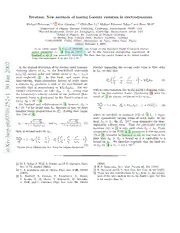
Erratum: New methods of testing Lorentz violation in electrodynamics PDF
Preview Erratum: New methods of testing Lorentz violation in electrodynamics
Erratum: New methods of testing Lorentz violation in electrodynamics Michael Hohensee,1,2,∗ Alex Glenday,1,2 Chih-Hao Li,2 Michael Edmund Tobar,3 and Peter Wolf4 1Department of Physics, Harvard University, Cambridge, Massachusetts 20138, USA 2Harvard-Smithsonian Center for Astrophysics, Cambridge, Massachusetts 02138, USA 3School of Physics, the University of Western Australia, 35 Stirling Hwy, Crawley 6009, Western Australia, Australia 4LNE-SYRTE, CNRS, UPMC, Observatoire de Paris, 75014 Paris, France (Dated: February 2, 2008) In an earlier paper [1] (hep-ph/0408006), the bound on the Standard Model Extension photon- sector parameter κ˜tr [2] (hep-ph/0205211) set by the heavy-ion storage-ring experiment of Saathoff et al. [3] was incorrectly reported. We show that the correct bound on κ˜tr which resulted from this experiment is in fact 2.2×10−7. 7 0 Inthe originalderivationofthe leadingorderLorentz- Further expanding the second order term to first order 0 violating effects of κ˜ to the Ives-Stilwell observable in κ˜ , we find that 2 tr tr n νaνp/ν02, second order and higher terms in βat = vat/c Ja wtimeree-vnaerygliencgt,edfra[m1].e-deIpnendtheinst lfiamcitto,rsanodf oarpdaerrtufnriotmy, βa2t(cid:18)cc22 + cc22 − cc2c −1(cid:19)=2βa2tκtr (3) a nonzero κ˜ produces a shift of the Ives-Stilwell ob- a p a p 0 tr 3 servable that is proportional to 4βatβlabκ˜tr. For ter- restrial experiments, we take βlab ∼ β⊕, noting that withnotime-variationduetotheEarth’schangingveloc- ity in the Sun-centered frame. Combining (3) with the 1 the laboratory’s velocity relative to the preferred (Sun- v centered) frame is dominated by the Earth’s orbital ve- result of [1] we obtain, to lowest order in κtr, 2 locity, β⊕ ∼10−4 [6]. 125 6×Fo1r0−S2aaisthfoaffr laanrgdercotlhlaabnoβra⊕t.orBseicnau[3se],ohfotwheisv,ewr,eβmatus≃t ννp0ν2a =1+2κtr(cid:2)βa2t+2βatβ⊕(...)(cid:3)+O(cid:0)κ˜2tr(cid:1), (4) 0 consider terms proportional to βa2t. Noting that (equa- 7 tion (10) of [1]) where as specified in equation (12) of [1] (...) repre- 0 sents sinusoidally varying terms of order unity. In the h/ ν =ν 1−βa2t , and ν =ν 1−βa2t , (1) limit βat ≫β⊕, the βa2t “DC” term dominates the time- p p 01−pβ (c/c ) a 01+pβ (c/c ) dependent sidereal term. Thus the previously derived at p at a - equation (12) in [1] is only valid when βat < β⊕. Upon p e then to second order in βat, comparisonto the RMS [4, 5] parameter αˆ (see equation h (2)of[3])boundedbySaathoff et al.,we findthatinthe iv: ννp0ν2a =1+βat(cid:18)ccp − cca(cid:19)+βa2t(cid:18)cc2a2 + cc2p2 − cac2cp −1(cid:19). lbimouintdthoantκ˜βtart. ≫Weβt⊕h,eraefboroeuncdonocnludαˆeitshaeqtutihvealleinmtittoseat X (2) on κ˜ by [3] is κ˜ <2.2×10−7. tr tr ∗ThanksDavidPhillipsandItayYavinforhelpfuldiscussions. r a [1] M.E.Tobar,P.Wolf,A.Fowler,andJ.G.Hartnett,Phys. (2003). Rev.D 71, 025004 (2005). [4] H. P.Robertson, Rev. Mod. Physics 21, 378 (1949). [2] V.A.KosteleckyandM.Mewes,Phys.Rev.D66,056005 [5] R.MansouriandR.U.Sexl,Gen.Rel.Grav.8,497(1977). (2002). [6] There are also contributions to βlab from βr, the compo- [3] G. Saathoff, S. Karpuk, U. Eisenbarth, G. Huber, nent of the lab’s motion dueto theEarth’s spin, but this S. Krohn, R. M. Horta, S. Reinhardt, D. Schwalm, is far smaller than β⊕. A. Wolf, and G. Gwinner, Phys. Rev. Lett. 91, 190403
